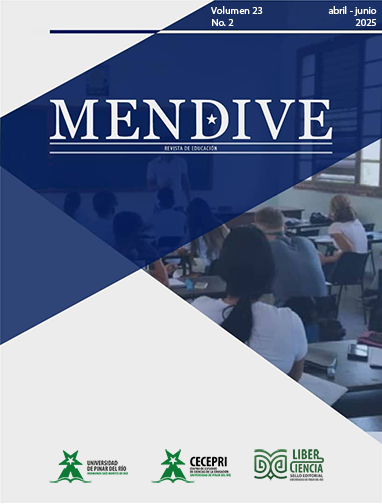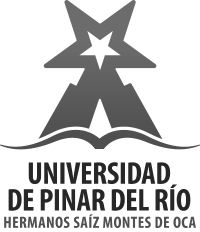Process of teaching and learning English focused on communication for professional purposes
Main Article Content
Abstract
Communication in English is becoming more important due to the growth of scientific, academic and working relationships between professionals. The diagnosis made to students of Electrical Engineering of the University of Moa, Cuba, corroborated that the scientific problem of this research is given by the deficiencies in the communicative performance, motivated by a process of Learning English not very coherent. This article aims to present a methodological approach of communication to contribute to the development of professional communicative skills of these students. The fulfillment of this purpose required the use of the methods: hypothetical-deductive, analytical-synthetic and systemic structural-functional, as well as the revision of documentation and the interview, as techniques of the empirical level. The result conceives of textual comprehension and communicative task as possible didactic procedures for the achievement of the intended communicative purposes, based on the implementation of the curricular strategy of English. It is concluded that the strategy reveals itself as the core of the communicative process, based on the conception of the text as the axis of the language activity, either as a product or as a process and the communicative task as a unit of the learning activity.
Downloads
Article Details

This work is licensed under a Creative Commons Attribution-NonCommercial 4.0 International License.
References
Alberteris, O., Rodríguez Sánchez, M., & Cañizares Hinojosa, V. (2018). Desafíos didácticos de la enseñanza-aprendizaje de las lenguas extranjeras en el contexto universitario cubano actual. Didáctica y Educación, 9(6), 303-329. https://revistas.ult.edu.cu/index.php/didascalia/article/view/847
Apa Terrero, Y., Olivé Iglesias, M. Á., & Lemus Reyes, F. (2019). Estrategia Curricular "Dominio del Idioma Inglés" para favorecer la comprensión de textos científicos desde la Química Inorgánica. Luz, 18(4), 14-22. https://www.redalyc.org/journal/5891/589162002005/589162002005.pdf
Arias Gonzáles, J. L., & Covinos Gallardo, M. (2021). Diseño y metodología de la investigación. Enfoques Consulting EIRL. https://www.biblioteca.unach.edu.pe/cgi-bin/koha/opac-detail.pl?biblionumber=3039
Consejo de Europa (2002). Marco común europeo de referencia para las lenguas: aprendizaje, enseñanza, evaluación. Instituto Cervantes. https://redined.educacion.gob.es/xmlui/bitstream/handle/11162/207011/Europa_lenguas_c.pdf?sequence=1
García Cormenzana, A. J., Rodríguez Picornell, Z., Mantilla Nieves, Y., & Sánchez Torres, R. G. (2020). Sistema de actividades para implementar la estrategia curricular de idioma inglés en quinto año de Medicina. Medimay, 27(2), 2 https://revedumecentro.sld.cu/index.php/edumc/article/view/e2665
García Hernández, K. C., Arenas Gutiérrez, R., Enríquez O'farrill, I., Garbey Savigne, E., Hidalgo Mederos, R., & Valcárcel, N. (2019). Estrategia didáctica interdisciplinaria para la enseñanza-aprendizaje del Inglés con Fines Específicos en la Licenciatura en Enfermería. Dilemas contemporáneos: Educación, Política y Valores, 6(2). https://www.dilemascontemporaneoseducacionpoliticayvalores.com/index.php/dilemas/article/view/656
Guevara Alban, G. P., Verdesoto Arguello, A. E., & Castro Molina, N. E. (2020). Metodologías de investigación educativa (descriptivas, experimentales, participativas, y de investigación-acción). RECIMUNDO, 4(3), 3. https://doi.org/10.26820/recimundo/4.(3).julio.2020.163-173
Harmer, J. (1983). The Practice of English Language Teaching (Third Edition). Longman. https://books.google.com.cu/books?id=178lAQAAIAAJ
Horruitiner Silva, P. (2006). La universidad cubana: El modelo de formación. Editorial Universitaria.
Hutchinson, T., & Waters, A. (1987). English for specific purposes: A learning-centred approach. Cambridge University Press. http://www.cambridge.org/9780521318372
Navarro Consuegra, M. A., Verdecia Cruz, A., García Cruz, S., & Fiol Cuenca, A. (2021). La comunicación oral en inglés en el contexto metalúrgico; una estrategia didáctica. REFCalE: Revista Electrónica Formación y Calidad Educativa, 9(3), 3.
Nunan, D. (1991). Communicative Tasks and the Language Curriculum. TESOL Quarterly, 25(2), 279-295. https://doi.org/10.2307/3587464
Torres Hernández, A., Rojas Rosales, M., Alvarez Góngora, Y., & Suárez Ceijas, A. (2020). La estrategia curricular del inglés en las asignaturas de Física en la carrera de Técnico superior de Biofísica Médica. Anatomía Digital, 3(3), 3. https://doi.org/10.33262/anatomiadigital.v3i3.1281
Zanón, J. (1995). La enseñanza de las lenguas extranjeras mediante tareas. Signos. Teoría y práctica de la educación, 14, 52-67. https://eleadictas.weebly.com/uploads/2/7/3/9/27394907/zann_laelemediantetareas_1995.pdf


